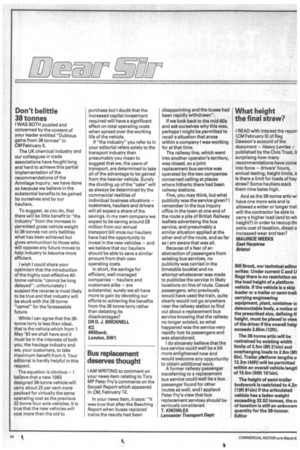Don't belittle 38 tonnes
Page 26

If you've noticed an error in this article please click here to report it so we can fix it.
I WAS BOTH puzzled and concerned by the content of your leader entitled "Dubious gains from 38 tonnes" in CM February 5.
The UK chemical industry and our colleagues in trade associations have fought long and hard to achieve this partial implementation of the recommendations of the Armitage Inquiry; we have done so because we believe in the substantial benefits to be gained by ourselves and by our hauliers.
To suggest, as you do, that there will be little benefit to "the industry" from the increase in permitted gross vehicle weight to 38 tonnes not only belittles what has been achieved but gives ammunition to those who will oppose any future moves to help industry to become more efficient.
I wish I could share your optimism that the introduction of the highly cost-effective 40tonne vehicle "cannot be long delayed"; unfortunately I suspect the reverse is most likely to be true and that industry will be stuck with the 38 tonne "camel" for the foreseeable future.
While I can agree that the 38tonne lorry is less than ideal, that is the vehicle which from 1 May '83 we shall have and it must be in the interests of both you, the haulage industry and we, your customers, to take maximum benefit from it. Your editorial is hardly helpful in this respect.
The equation is obvious — I believe that a new 1983 designed 38-tonne vehicle will carry about 25 per cent more payload for virtually the same operating cost as the previous 32 tonne four-axle vehicles. It is true that the new vehicles will cost more than the old to purchase but I doubt that the increased capital investment required will have a significant effect on total operating costs when spread over the working life of the vehicle.
If "the industry" you refer to in your editorial refers solely to the transport industry then presumably you mean to suggest that we, the users of transport, are determined to take all of the advantage to be gained from the heavier vehicle. Surely the dividing up of the "cake" will as always be determined by the commercial realities of individual business situations — customers, hauliers and drivers will all expect a share of the savings. In my own company we expect to be saving around a million from our annual transport bill once our hauliers have had the opportunity to invest in the new vehicles — and we believe that our hauliers should be able to save a similar amount from their own operating costs.
In short, the savings for efficient, well-managed companies — hauliers and customers alike — are substantial; surely we all have more to gain by devoting our efforts to achieving the benefits from the 38 tonne lorry rather than debating its disadvantages?
DR D. J. BRICKNELL 'Cl, Millbank, London, SW I.












































































































